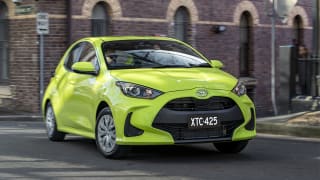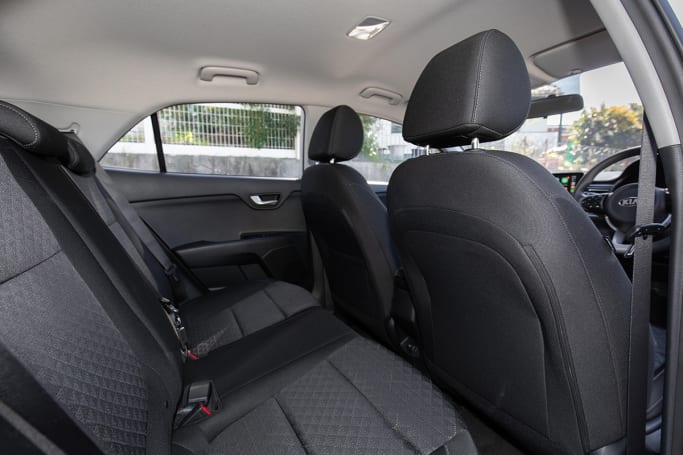
Toyota Yaris Ascent Sport 2021 review: snapshot
The Ascent Sport marks the cheapest way into the Yaris family, costing $22,130 for a vehicle with a manual transmission, and $23,630 for a CVT automatic.
Browse over 9,000 car reviews
Did you know there are Kias which cost $65,000? But not the Kia Rio. Nope, see, even though the brand has evolved to the point where it boasts luxurious SUVs like the Sorento and sports cars like the Stinger in its line-up, it's also kept the cars which made it popular – like the little Rio hatch, which is still super affordable.
I've tested the S grade which is also the least expensive Rio in the range and a model that's recently been updated with a new look and better cabin tech.
So, is the Rio as good as rivals like the Mazda2 or Toyota Yaris? Is there anything this grade doesn't have which you should know about? I can tell you now. Definitely.
| Kia Rio 2021: S | |
|---|---|
| Safety rating | |
| Engine Type | 1.4L |
| Fuel Type | Regular Unleaded Petrol |
| Fuel Efficiency | 5.6L/100km |
| Seating | 5 seats |
| Price from | $13,640 |
The Rio is a super affordable car and the S is the lowest priced grade in the range at $20,390. That's the list price, but at the time I wrote this review Kia was selling the Rio S for a drive-away price of $19,990.
It's the entry grade Rio, but there are still some good standard features such as the 8.0-inch display with wireless Apple CarPlay and Android Auto, Bluetooth connectivity, six-speaker stereo, cloth seats, and (manual) air-conditioning. Those wheels aren't alloys, though. Those are plastic hubcaps on steel rims.

Is it good value? Yes, but it's missing some pretty important safety tech such as AEB. If you can find $2K more you can step up to the Sport grade which has the safety tech. You'll also get more convenience and fancy features such as cruise control, 17-inch alloy wheels and heated folding mirrors, but it's the safety equipment that makes the upgrade to the Sport something to be seriously considered.
In comparison to a Toyota Yaris the Rio S is about $3K less expensive than its equivalent. Suzuki, however, is able to offer the Swift at a very low list price of around $19,000.


The Rio was updated in 2020 and part of that revamp included a change to its grille, which now has a more 'pinched in' look and some restyling to the front bumper.
One of the appealing things about its looks (to me) is that while the Rio is categorised as a 'Light' car (smaller than 'Small') it doesn't look dinky or fragile.
The Rio's dimensions show it to be wider and longer than rivals such as the Toyota Yaris, at 1725m wide, 1450mm tall, and 4070mm long.
The Rio S's cabin looks more upmarket than its price would suggest. Yes, there are hard plastics galore, but the design is stylish. The only hard plastic I'm not okay with is on the driver's door armrest which was a pain in the elbow.
The cloth seats are also in the Sport grade, and they appear to be hard-wearing fabric with a jazzy business design. The seats themselves are very comfortable.

A big boot for the size, large rear doors, great legroom and headroom.
There are cars larger than the Rio with far less practicality. I'm 191cm (6'3") tall and I can sit behind my driving position without my knees touching the seatback and headroom is excellent back there, too.
Those large rear doors open wide making it easy to get in and out. If you have children, like I do, you'll like that extra space for putting them into the car seats.
There's good cabin storage with large front and rear door pockets, there are two cupholders, a centre console bin and double-decker shelves in front of the shifter.

For charging devices there's a USB port and a 12V outlet in the front and another USB port in the second row.
The boot is large for the class at 325 litres, too. That's bigger than many of its rivals, including the Toyota Yaris and Mazda 2. Legroom in the Rio is also better than those cars.

The Rio S has a 1.4-litre four-cylinder petrol engine making 74kW/133Nm. It's the same engine, which is in the Sport grade. Only the top-of-the-range GT-Line Rio has the three-cylinder turbo, but it's not any more powerful nor much more fuel efficient than the four-cylinder in the S.
The S grade comes in a choice of six-speed manual or six-speed automatic driving the front wheels. Our car had the auto which performed fairly smoothly, although it's not the fastest gear slinger.

Kia says the petrol engine should use 6.0L/100km after a combination of open and urban roads. I drove the Rio S for week, living with it like you might – school drop offs, shopping centres, city streets, motorways, you name it.
After bang-on 100.0km in the Rio I needed 8.4 litres to top the tank back up to full, which, surprise, surprise, equates to 8.4L/100km.
The S is the only grade in the Rio range not to have autonomous emergency braking (AEB) or other advanced safety tech such as lane keeping assistance.
If you can stretch the budget another $2K, that will get you into the Sport grade which has the safety equipment. It's for this reason that the score for safety here is so low.
Back in 2017 when the Rio was safety assessed by ANCAP it wasn't necessary for cars to have AEB to achieve the maximum five-star rating this small car received. These days the bar is a lot higher.
Still the Rio S has a reversing camera, rear parking sensors, and a suite of airbags including front driver and passenger airbags, front side air bags and curtain airbags which cover the second row.
For child seats there are two ISOFIX points and three top tethers mounts across the second row.
A space saver spare wheel is under the boot floor.
New-gen cars such as the Yaris are better equipped with safety tech.
Basic Warranty
7 years / unlimited km warranty
ANCAP Safety Rating

The Rio is covered by Kia's seven-year/unlimited-kilometre warranty. Servicing is recommended at 12 month/15,000km intervals and pricing is capped. You're looking at about $3000 over the seven years.
This is the best warranty out there, beating its main rivals by at least a couple of years.

The Rio is great to drive. I bet you didn't think this would be among the little Kia's best attributes.
Sure, its engine feels like it could do with a bit more grunt, but the steering is accurate and smooth, the driving position is excellent, and the visibility is good. Better than all that, though, is the ride, which is comfortable, and handling is great for a car this price.
Compared to the Toyota Yaris the Rio doesn't feel as sporty to drive, but it's far more comfortable than a Mazda2.

The Rio S has some formidable strengths. Price and value-for-money are outstanding, it looks stylish, it's super practical with a good boot and great cabin space for a little car and it's great to drive. The one weakness is a big one – the lack of safety tech. It's for this reason we strongly recommend you step up to the grade above, the Sport, which comes standard with AEB.
| Vehicle | Specs | Price* | |
|---|---|---|---|
| S | 1.4L, ULP, 6 SP AUTO | $15,730 – 20,130 | 2021 Kia Rio 2021 S Pricing and Specs |
| GT-Line | 1.0L, ULP, 7 SP AUTO | $19,470 – 24,640 | 2021 Kia Rio 2021 GT-Line Pricing and Specs |
| Sport | 1.4L, ULP, 6 SP AUTO | $16,830 – 21,560 | 2021 Kia Rio 2021 Sport Pricing and Specs |
| SX | 1.4L, ULP, 6 SP AUTO | $18,700 – 23,650 | 2021 Kia Rio 2021 SX Pricing and Specs |
| Price and features | 8 |
|---|---|
| Design | 8 |
| Practicality | 8 |
| Under the bonnet | 7 |
| Efficiency | 6 |
| Safety | 5 |
| Ownership | 9 |
| Driving | 8 |
$16,500
Lowest price, based on 99 car listings in the last 6 months